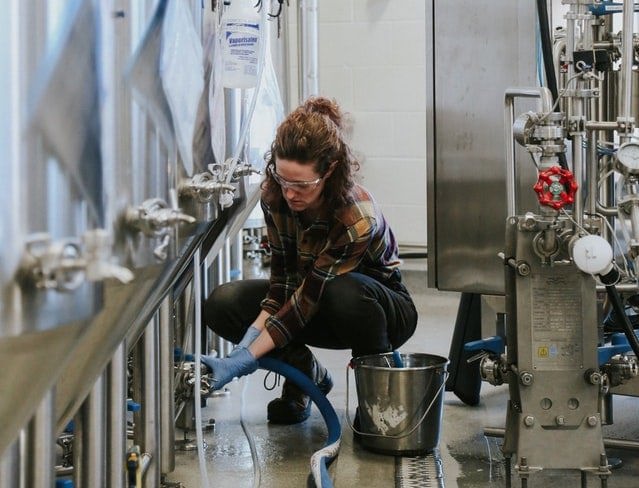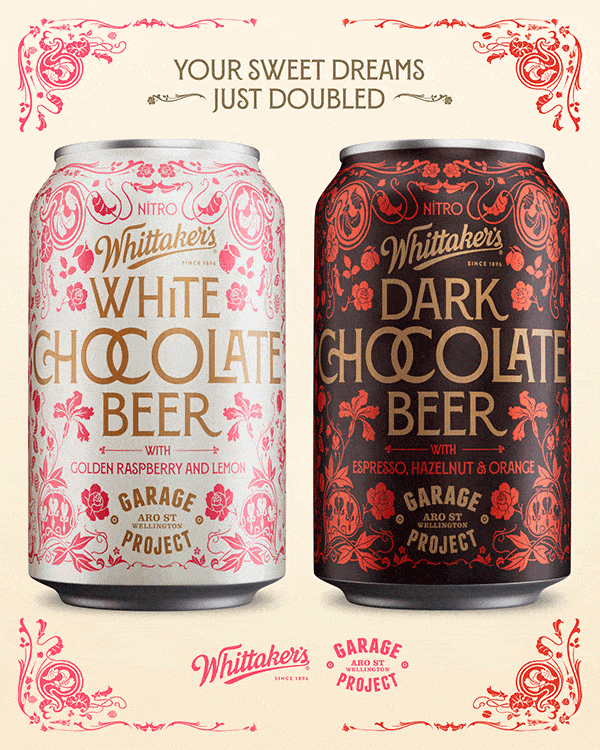
Craft brewers are an inventive lot. Strategies to grow their brand and brewery sales are often as creative as the recipes, packaging, and pairings for their beers.
With the added uncertainty of the ongoing global pandemic, the need to implement effective business strategies - and have the right brewery software in place - has never been more critical. From contract brewing to collaborations and taproom events, the following nine strategies can help craft breweries to grow their brand and increase brewery profit margins.
1. Contract brewing
Contract brewing is an arrangement between a contracting brewery and a host brewery. It works to help the contract brewer reduce costs and the host brewer to optimise capacity and increase revenue, also creating a more efficient beer supply chain.
Ultimately, the contracting brewery or brewer hands production control of their product to the host brewery. The contracting brewery retains ownership of their recipes and brand, but the host brewery is generally responsible for the beer production, bottling, labelling, government licences, taxes and maintaining records.
Contracts can vary slightly, and specifics are detailed in the legal agreements. The pros and cons of contract brewing include:
Lower entry costs
Brewery start-up costs can be expensive. Contract brewing lowers entry barriers for start-ups, providing a greater chance of success. Entering a contract brewing agreement can eliminate the costs of renting or buying brewery space, purchasing the necessary equipment, and hiring staff.
Lower entry costs however mean potentially smaller margins because the contracting brewer is paying another business to undertake a significant portion of the work. For start-up brewers, contract brewing means that you have less community presence which can limit marketing opportunities and alienate die-hard craft brew enthusiasts.
No equipment maintenance
Without facilities or brewing equipment such as kettles, boilers, and fermentation tanks contracting brewers avoid any necessary maintenance and repairs.
Host brewers have already purchased brewery equipment and are already responsible for its maintenance and routine cleaning procedures. However, a host brewery may not be operating at full capacity and can therefore benefit from adding contract beers into their production schedule as a sustainable way to increase overall profits.
Increased capacity
Contract brewing helps smaller brewers to increase capacity and grow their brand. By outsourcing beers with greater shelf stability, large-scale brewing of these products will optimise the brew process to a scale that targets customers looking for an everyday craft beer.
Freeing up their own operations in this way allows a smaller operator to focus on more speciality styles brews to improve their craft brand. Although it is harder to manage production when you are creating specialty or one-off beers implementing a robust brewery software system will make it easier. That’s because these speciality beers are generally tweaks on existing beer recipes. Brewery software helps protect the margin on short-run brews that are only available for a limited time.
Make the arrangement work for you!
Entrusting recipes and production to another business means you are potentially handing over the overall success of your brand to someone else. There are many arrangements available to craft brewers looking to contract but it is important to ensure a successful, reliable relationship is developed with the brewery you contract to.
Handing over control of your prized brews can be difficult. However, it becomes more appealing once you consider the cost benefits and potential long-term opportunities. Although it can also be a way to effectively outsource marketing and sales activities to enhance growth and improve profits via a channel partner.
Contract brewing also acts as a bridge to geographic expansion. Implementing contract brewing arrangements with breweries in other countries enables brewers to gain access to new markets through local networks. Order fulfilment is quicker, freshness is guaranteed, financial gains can be made through a reduction in shipping costs and you lower your environmental impact by brewing where your market is.
 Contract brewing can be a great way to explore new markets, minimise cost and grow your brand
Contract brewing can be a great way to explore new markets, minimise cost and grow your brand
2. Crowdfunding
Crowdfunding is an equity or reward-based form of alternative financing. It is the way to fund a project or venture by raising varying amounts of money from many people. Several internet-based crowdfunding platforms can be used to raise funds for personal, charitable, or business reasons.
Reward-based crowdfunding
Reward-based crowdfunding is a one-time transaction between the campaign backer and the business they are supporting. People back the funding campaign with a monetary contribution and receive merchandise or something else in return. Generally, the gift received varies based on the size of the donation.
Equity crowdfunding
Equity crowdfunding is different to reward-based crowdfunding in that you are primarily selling equity ownership in the company. Some campaigns will also include rewards and discounts, but it is mainly a way for interested parties to invest a small amount of money in return for a small amount of ownership.
Behemoth Brewing financed its new production facility and taproom by issuing shares via a crowdfunding platform. $2.06m of capital was raised and in addition to gaining 635 new shareholders, the campaign also garnered great press coverage and naturally, every person that pledged funds became a loyal Behemoth customer.
If you choose to go the route of crowdfunding, research the various platforms available to find the one that is the best fit for your needs. Be sure to launch your campaign with as much panache as you can. Use social media platforms, email marketing lists and loyal customers to create excitement around the campaign, promoting your cause and the reasons behind it. Build momentum by getting early upfront results that will provide further promotional opportunities.
3. Brewpubs
A fusion between a brewery and a restaurant, brewpubs brew and sell a significant portion of their beer on-site in combination with food services and offerings.
The trend towards brewpubs continues to grow with breweries looking to new strategies as the competitive landscape of craft brewing becomes more crowded. Where previous strategies looked to grow sales by expanding market reach, breweries are now concentrating on growing their business in their local areas by gaining a loyal market share. Brewpubs offer a way to do this.
One benefit of the brewpub model is that the net income achieved through brewpub transactions is generally better than through wholesale sales because the margins are usually larger. However, the transition from brewery to brewpub is not a simple one.
Most brewers come into the industry through a love of the craft and a flair for the creative. But it is one thing to build and run a production-based brewery operation, and another to manage a hospitality business. Any brewer looking to go the brewpub route really needs to have someone on staff to manage the hospitality and restaurant areas of the business.
Additionally, restaurants generally measure profitability through week-to-week performance and breweries on a month-to-month performance. Invest in brewery software to optimise performance, production, and productivity analysis and data-driven decision making.
A crucial KPI that brewery software should monitor is gross margin by revenue centre. If you are operating different types of businesses under the same roof, such as beer production, a taproom or food services, ensure they are separate. Measure financial metrics against what is common for that type of industry centre.
4. Taprooms and tasting rooms
A taproom or tasting room is essentially a bar where you serve your own beer. They are a much easier business model to execute than that of a full-service brewpub. Taprooms enable brewers to increase margins and sell larger volumes by offering takeaway beers such as flagons, riggers, and cans. Give customers the choice to BYO refillable containers.
For those brewers running tap and tasting rooms, it’s also a great idea to partner with local food trucks. Having food available is important because it tends to keep customers staying longer and depending on local liquor laws, may be a legal requirement. With customers purchasing food directly from the food trucks it frees you of the hassle of food management.
 Grow brewery sales by expanding to a brewpub or taproom but don't forget to track the right KPIs and metrics
Grow brewery sales by expanding to a brewpub or taproom but don't forget to track the right KPIs and metrics
5. Influencer marketing
Online influencer marketing is a huge deal. Influencers have the power to affect the purchasing decisions of their audience based on authority, knowledge, or position.
So, getting your brew highlighted by beer influencers puts you in front of their ready-made audience. Having these influencers say nice things about your beer is bound to lead to more of their followers wanting to try for themselves what you’re brewing.
Tapping into the influencer's ready-made communities is a great way for breweries to spread meaningful news. However, you should take the time to ensure the influencers you use are a good fit for your brand and allow them creative freedom because craft enthusiasts are all about authenticity.
Here are just a few examples of popular craft beer influences in Australia, New Zealand, the United Kingdom, and the United States:
Australian beer influencers
Pia Poynton is a certified Cicerone, which means she has demonstrated a robust knowledge of beer, beer service and competence in evaluating beer quality and identity by taste. A beer rep, marketer for Nail Brewing, freelance writer, and the girl behind popular Girl + Beer blog, Pia has some 4.8k followers on Instagram.
View this post on Instagram
Having written guest columns for magazines, other noted beer blogs and with hands-on experience at a variety of pubs, Pia has a diverse knowledge of the industry making her blog a popular site to browse for hours.
Another Aussie influencer is Luke Robertson, the man behind Ale of a Time. One of Australia’s best beer blogs because they don’t just cover the basics of flavour and style. Through podcasts, articles and interviews, Ale of a Time keeps readers current on the latest industry news and even provide behind-the-scenes glimpses into emerging craft breweries.
View this post on Instagram
New Zealand beer influencers
The daughter of a brewer, Denise Garland is a journalist and beer blogger. Denise has worked in the beer trade overseas and written beer-related articles for SOBA and the Spinoff. In 2019 Denise won the NZ Beer Media Award for highlighting Māori cultural appropriation in the beer industry.
Matt Kirkegaard, founder of the Brews News and Beermatt blog, is a prominent beer educator and commentator. Technically Matt is an Australian-based influencer, but Brews News' was so popular with Kiwi craft lovers a sister-site was launched dedicated to local news, brewery openings and craft beer events in New Zealand.
View this post on Instagram
UK beer influencers
Melissa Cole is an award-winning writer and a leading beer and food expert who has collaborated in making beers with several breweries. Another certified Cicerone, Melissa has nearly 37 thousand followers on Twitter and is regularly invited to judge beer competitions in Brazil, Europe, New Zealand, and the United States. Melissa has authored the Little Book of Lager: A Guide to the World's Most Popular Style of Beer and Let Me Tell You About Beer: A Beginner's Guide to All Things Brewed.
View this post on Instagram
A freelance journalist, Adrian Tierney-Jones covers topics that include beer, food, pubs, and travel. Adrian has written multiple books, and his articles have been published in the Daily Telegraph, Sunday Times Magazine, and the pub trades leading magazine, Inapub. He is a jury member at the Brussels Beer Challenge, Chair of Judges at the World Beer Awards and the editor of 1001 Beers: You Must Try Before You Die.
View this post on Instagram
US beer influencer
Josh Noel is an author and journalist who covers topics such as food beer and travel. His articles feature in many publications including the Miami Herald, Chicago Tribune, Los Angeles Times, and even Stuff.co.nz.
Josh has 12.8 thousand followers on Twitter, over two thousand on Instagram and his books include How Craft Beer Became Big Business and Barrel-Aged Stout and Selling Out: Goose Island, Anheuser-Busch.
View this post on Instagram
6. Collaborations
Collaboration beers are when two or more breweries work together to create a new, generally one-off, or limited-edition brew. Collaboration beers are increasingly popular in the craft brewing industry because they support the craft ethos of working together and they raise awareness of each of the brewer’s products.
 New Zealand's Garage Project brewery and Whittaker's Chocolate teamed up to make chocolate flavoured beer in Nov 2020
New Zealand's Garage Project brewery and Whittaker's Chocolate teamed up to make chocolate flavoured beer in Nov 2020
Creating a collaboration beer usually sees the brewers formulating a recipe beforehand and one will generally act as the host brewery. The hosting brewery undertakes most of the responsibilities for the brew day: sourcing ingredients, taking on the actual brewing and managing the packaging and label design.
Five Boroughs Brewing Co. of Sunset Park, Brooklyn orchestrated a collaborative feat that brought together all nine of the new breweries that launched in New York in 2017. The brew day was the largest brewery collaboration New York had ever seen and the resulting beer, called Class of 2017 New York City Pale Ale, was an enormous hit.
7. Product collaborations
In addition to beer collaborations with other brewers, breweries will sometimes team up with related products, seemingly non-related products and even charities. For example, New Zealand’s Garage Project teamed up with Proper Crisps to release beer flavoured chips.
The Glenn Avenue Soap Co, in the United States teamed up with seven local craft breweries to develop a line of soaps made with beer. The soap products included IPA’s, stouts, and a porter.
During 2020’s Covid-19 lockdown, Brisbane’s Archer Brewing led the first not-for-profit beer collaboration beer. With seven local businesses and another 22 independent breweries, they collaborated to raise money for the LIVIN mental health education charity.
8. Growing a direct-to-consumer channel
Diversifying sales channels is important to keep your beer flowing. In the current climate of snap lockdowns due to even a single case of the coronavirus, it becomes obvious that you don’t want to be selling only to pubs and restaurants.
Creating an eCommerce B2C channel helps to get your beers direct to your consumer and numerous eCommerce tools available to help set up your eCommerce store, simply and quickly.
Some useful tips to consider when setting up a B2C channel:
- Know what you are selling, B2C customers are likely to purchase six-packs or cartons
- Ensure your eCommerce site is uniform in design, easy to navigate and on-brand
- Know the legal requirements, in most countries this is having an 18+ condition of entry
- Connect to effective inventory management and brewery software tools
- Market to a new B2C audience through social media and digital marketing spend
- Have the logistical side of eCommerce sales sorted to ensure seamless shipping and delivery
9. Merchandise
A natural fit with eCommerce sales channels, merchandise offers both an additional revenue stream and a way to get your brand out into the world. Merchandise is typically things such as t-shirts, caps, and glasses but there are no limits to what you can do in the merchandise space. The Wakachangi beer even sells branded ringtones.
How breweries grow on-premises beer sales
On-premise beer sales is a sales channel where the brewery provides its beer product to bars and restaurants typically by the keg. The on-premises sales channel is a great way to get your brand in front of a larger audience, where they consume it. However, with limited tap capacity, competition is tough.
The disadvantage of on-premises sales is that nearly all distribution is incentivised in some way, such as free shipping or promotional materials. Market consolidation is eroding margins and the big beer companies have a stronghold or exclusive rights in many venues.
The key to successfully securing on-premises beer sales is preparation and planning. Consider what outlet style and drinking occasion best suit the beer you are pitching. The best way to secure tap permanency is if customer demand is strong.
